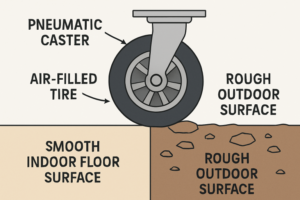The term “pebble convex” may sound abstract at first, but it describes a concept rooted deeply in geology, material science, and even mathematics. It refers to the characteristic surface shape of naturally weathered or eroded stones—specifically pebbles—which typically exhibit smooth, rounded, outwardly bulging surfaces that are convex in nature. Understanding pebble convexity not only gives us insight into natural processes but also helps in applications such as soil science, sedimentology, landscape evolution, and even artificial shaping of materials. This article will explore what pebble convex means, how such shapes form, their scientific implications, and where the concept applies in real-world contexts.
Understanding Convexity in General Terms
Before diving into the specific characteristics of pebble convex surfaces, it is essential to grasp what “convex” means in geometric and physical terms. A surface or object is said to be convex when it curves outward, with no internal angle greater than 180 degrees, and any straight line drawn between two points on its surface lies entirely within the object. The opposite of convex is concave, where surfaces curve inward. A simple example of a convex object is a sphere or dome.
In the context of natural materials like pebbles, convexity refers to the overall rounded, bulging surface of the pebble. Rather than having sharp edges, flat surfaces, or indentations, a pebble convex shape is smooth and tends to bulge outward uniformly. This surface curvature results from various geological forces acting over time, which smooth out irregularities and produce a convex profile.
Formation of Pebble Convex Shapes in Nature
The process of forming pebble convex shapes is governed primarily by natural erosion, mechanical weathering, and transportation mechanisms in the environment. Pebbles are originally part of larger rock masses that undergo fragmentation due to tectonic activity, temperature variations, frost action, and chemical weathering. Once dislodged, these rock fragments become subjected to continuous physical interactions that alter their shapes.
Here are the primary steps that contribute to the convexity of pebbles:
- Initial Fragmentation: When a larger rock breaks apart, it results in angular fragments. These fragments have rough, sharp edges and uneven surfaces. These initial shapes are far from convex and are highly irregular.
- Transportation by Water: Rivers, streams, and coastal waves play a major role in shaping pebbles. As rock fragments are transported downstream or along shorelines, they collide with other rocks and sediments. These collisions break off sharp edges and gradually round off the stone. The water itself acts as a buffer and abrasive, gently grinding the surfaces over time.
- Abrasion and Rolling: The tumbling action caused by rolling in a streambed or being tossed by waves further contributes to the smoothing process. The longer a pebble is subjected to these forces, the more it develops a convex surface. Angularities are worn down, and the pebble starts to assume a more symmetric, bulging form.
- Surface Erosion and Polishing: Apart from mechanical impacts, chemical weathering can also play a role in smoothing the pebble’s surface. Minerals on the surface may dissolve or react with environmental agents like water and oxygen, further enhancing the smooth, convex appearance.
- Final Equilibrium Shape: Over time, a state of equilibrium is reached where further erosion doesn’t significantly change the shape of the pebble. At this point, the pebble exhibits what we call a “pebble convex” shape—uniformly rounded, smooth, and devoid of sharp projections.
This transformation process can span hundreds or thousands of years, depending on environmental conditions, the type of rock, and the intensity of erosional forces.
Pebble Convex in Geological and Geomorphological Contexts
In geology, the study of pebble shapes—especially their convexity—can reveal valuable information about the history of sediment transport, environmental conditions, and geological timeframes. Pebble convexity can serve as a proxy indicator for:
- Transport Distance: Highly convex and well-rounded pebbles typically indicate long transport distances. The more a pebble has been subjected to rolling and abrasion, the more convex it becomes. By analyzing the degree of convexity, geologists can estimate how far a pebble has traveled from its source.
- Erosional Intensity: Regions with fast-flowing rivers or energetic coastal systems tend to produce more convex pebbles, as high energy increases the rate of abrasion.
- Depositional Environment: The convexity of pebbles can also help identify whether a pebble was deposited in a river channel, beach, glacial moraine, or desert dune field. Beach pebbles, for example, tend to be more symmetrically convex due to uniform wave action, while glacial pebbles may have less pronounced convexity.
- Rock Type: The mineral composition and hardness of the original rock greatly influence the final shape of the pebble. Softer rocks round off more quickly, while harder ones retain angular features longer.
Mathematical and Physical Modeling of Pebble Convexity
Interestingly, the shape evolution of pebbles has also been studied using mathematical models. Scientists have applied geometric and physical algorithms to simulate how an initially angular fragment transforms into a convex pebble through repeated erosion and abrasion. One such method is the use of curvature-driven flow models, where surface points with higher curvature erode faster, leading to a smoothing effect over time.
Mathematical studies have shown that in the absence of external constraints, an angular body subjected to uniform abrasion will eventually converge toward a spherical, convex shape. This is known as shape convergence, and it reinforces the observation that natural processes favor the development of convexity over time.
There are also computational simulations that model how the distribution of forces during tumbling or impact changes the rate and pattern of erosion. These simulations help refine our understanding of how various environmental parameters affect the final convexity of a pebble.
Applications of Pebble Convex Understanding in Real-World Scenarios
Though the concept may sound abstract or purely academic, pebble convex shapes have several practical implications in different fields:
- Civil Engineering and Construction: In concrete production, the shape of aggregates (often pebbles or crushed stone) affects the workability, strength, and durability of the mixture. Convex, rounded pebbles reduce friction and enhance flow, which is beneficial in creating smooth concrete surfaces. Understanding pebble convexity allows engineers to select the appropriate materials for specific construction applications.
- Archaeology and Anthropology: Pebble tools made by early humans often show intentional shaping toward convex forms. Studying the natural convexity of pebbles helps archaeologists differentiate between naturally worn stones and human-modified tools.
- Landscape Design and Aesthetics: Smooth, convex pebbles are often used in landscaping due to their pleasing appearance and tactile quality. Understanding their formation can guide artificial tumbling techniques to recreate similar surfaces in a controlled setting.
- Environmental Monitoring: In river restoration projects or coastal erosion studies, monitoring the shapes of pebbles can indicate changes in sediment dynamics. A shift in pebble convexity across a region may reflect alterations in flow patterns, human impact, or climate-induced changes.
- Material Sciences and Artificial Erosion Studies: By simulating the convexification process in lab environments, scientists can study wear resistance, durability, and surface dynamics of various materials. This is particularly useful in designing components subjected to friction and impact, such as machine parts and wear-resistant coatings.
Cultural and Symbolic Aspects of Pebble Convex Forms
Beyond the scientific domain, the concept of a smooth, convex pebble has symbolic and aesthetic appeal. In many cultures, pebbles—especially those with perfect convex shapes—are seen as tokens of balance, peace, and eternity. Their tactile smoothness and simple beauty have made them popular in:
- Zen gardens as elements of meditation and contemplation.
- Spiritual practices, where pebbles symbolize grounding or mindfulness.
- Art and sculpture, where the natural convex form is replicated in ceramics, carvings, and installations.
Their convexity is part of their charm—representing a natural refinement over time, a metaphor for how life’s trials and passages wear away the sharpness and create something harmonious.
Challenges and Misconceptions About Pebble Convexity
While the term “pebble convex” suggests a universal form, it is important to remember that not all pebbles become perfectly convex. Several factors can hinder the process:
- Abrupt deposition: If a pebble is not transported long enough, it retains angular features.
- Variable erosion: Uneven abrasion due to mineral inconsistencies can cause asymmetric shapes.
- Environmental barriers: Some pebbles become embedded or locked in sediment before convexity can fully develop.
Moreover, artificial interference—like human construction, mining, or damming—can disrupt the natural cycle of erosion and transportation, leading to a collection of irregular, partially eroded stones.
ALSO READ: BVX: The Future of Secure Biometric Virtual Exchange and Digital Identity
FAQs About Pebble Convex
1. What does “pebble convex” mean in geology?
“Pebble convex” refers to the smooth, outwardly bulging surface shape of pebbles formed through natural erosion, abrasion, and transportation processes. It characterizes a rounded, curved profile typically found in riverbeds and beaches.
2. How does a pebble become convex over time?
A pebble becomes convex through repeated abrasion as it tumbles in rivers or along shorelines. Over time, collisions and surface erosion smooth out sharp edges, resulting in a rounded, convex shape.
3. Can all rocks form convex pebbles?
Not all rocks will form perfectly convex pebbles. Softer, more homogenous rocks tend to round off more easily, while harder or layered rocks may retain angular features longer. Environmental conditions also play a major role.
4. Why is the convexity of pebbles important to scientists?
Pebble convexity helps geologists and environmental scientists infer transport history, energy levels of depositional environments, and sediment dynamics. It’s a useful indicator in studying geological and ecological systems.
5. Are convex pebbles used in construction?
Yes, convex or rounded pebbles are often preferred in construction, especially in concrete and decorative landscaping, due to their smooth shape, which enhances material flow and visual appeal.









